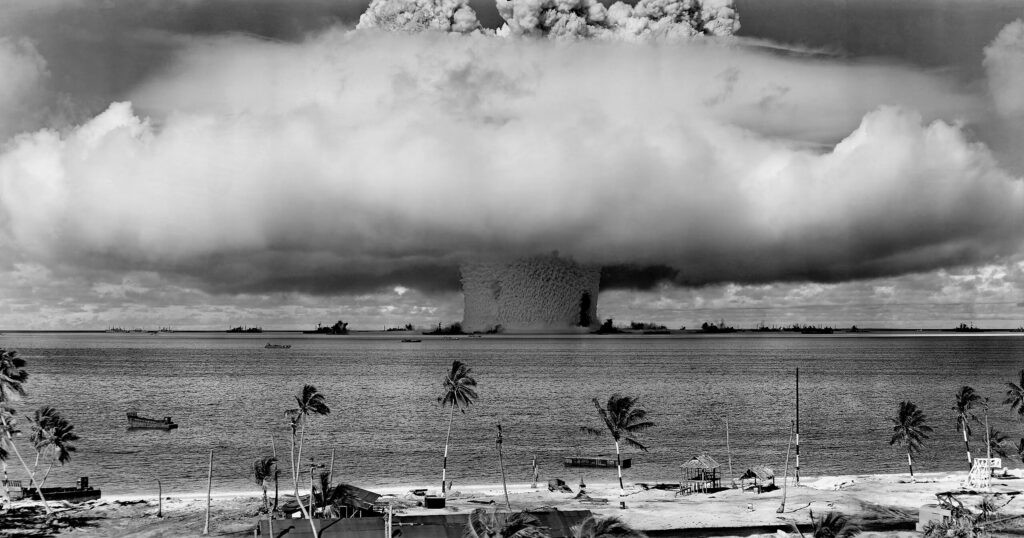After the Fallout
On jellyfish babies, my father’s pain, and the legacy of nuclear testing in the Pacific

The first time I learned about Enewetak Atoll, I was 10 years old. I’d found a U.S. Army booklet describing the island chain and asked my father about it. He gave me two pieces of information: that there were coconut crabs on Enewetak bigger than armadillos and that he was not allowed to talk about what he did there, ever.
My father, G. B. Youmans, was a stiff-necked Georgia man whose credo was, “A promise made is a debt unpaid.” He’d worked as a cable technician on Enewetak in 1954, as part of President Truman’s directive, carried out jointly by the Army and the Navy, to test nuclear weapons on the Marshall Islands so as “to determine the effect of atomic bombs on American warships.” This assignment required an oath of secrecy, an oath my father would honor with his life.
The mystery of Enewetak set me to wondering what kind of exciting secret life he must have led before he became a milkman in Jacksonville, Florida. I scanned the Pacific Ocean on a globe, finding Enewetak among the Marshall Islands. Such tiny dots in all that blue! It seemed to me the islands and their inhabitants could disappear in an instant and hardly anyone would know.
Some 10 years later, Enewetak came up again while my father lay in a hospital for three months, undergoing two operations for his fungus-filled, hemorrhaging lungs. The doctors were baffled, saying it wasn’t cancer, and it wasn’t quite like black lung, either.
His lungs weren’t like anything they’d ever seen before.
Though my father had kept his word, never going into detail about his experiences, he did reveal to his pulmonary doctors that he’d spent 13 months on Enewetak. He came home from the hospital with four ribs removed, half a lung, and a drainage tube protruding from his body.
He was 48 years old. He would spend the rest of his life tethered to an oxygen machine.
If my father had not been stationed on Enewetak, I wouldn’t have been led to read books on the atomic bomb testing program in the Pacific, which lasted for 12 years, until 1958. I wouldn’t, for all these years, have obsessively watched documentaries and old newsreels or followed the rare stories in the news, trying to understand what had happened to him. For the Marshallese people, this is a tragic story they’ve had to tell and retell for 78 years, in pursuit of anything that looks like justice, reconciliation, or even an apology.
Their story begins in February 1946 when, on behalf of the U.S. government, Commodore Ben Wyatt appeared on the island of Bikini. He explained to the people living there that they were like the children of Israel, being led into the Promised Land, and that they must leave their island for the “good of mankind and to end all world wars.”
King Juda, their leader, knew the people had little choice when he replied, “We will go believing that everything is in the hands of God.” For their sacrifice, the people of Bikini, Enewetak, and the other atolls affected by fallout lost their home, their culture, and a self-sustainable existence, and they were left with ongoing afflictions linked to radiation exposure, including certain kinds of cancer. Women have faced a greater risk of having miscarriages, stillbirths, and babies born with severe birth defects, including “jellyfish babies,” infants born with translucent skin and without bones.
In 1946, MGM Studios made a short film called Bikini, the Atom Island. In it, you can watch the meeting between Commodore Wyatt and the people of Bikini. You can see King Juda offer his sorrowful response. The island, with its white sand, pandanus and coconut trees, tidy homes, and community buildings, looks idyllic. Throughout the film, the voiceover narrator speaks paternalistically, praising the “humble Bikinians” for “contributing their little all.” We witness the island’s residents packing up their belongings and boarding the transport ship that will take them to the island of Rongerik, their outrigger canoes attached to the side.
As they sail away from a place that will never be habitable again, the girls and young women wave handkerchiefs and sing hymns. Men with stoic faces sit on the deck of the ship. The film ends with an image of the American flag flying over the island as the narrator declares, “A little island which for so long has meant so little to the world, now means so much.”
Bikini, the Atom Island is painful to watch. I feel a similar pain when I look at pictures of my father as a smiling, younger man. I know how it all turns out. I also know that what the narrator intoned is no longer true. The islands that once meant so much now mean so little. Or, as Henry Kissinger brutally stated in 1969 when addressing the displacement of the Marshallese: “There are only 90,000 of them out there. Who gives a damn?”
It seems that the United Nations Human Rights Council does. At the council’s 57th session, held in Geneva last year, U.N. Deputy High Commissioner Nada Al-Nashif discussed a report, produced by the Office of the High Commissioner of Human Rights, that seeks to better understand the effects of those 12 years of nuclear testing. The report was the result of yearlong “workshops, meetings and consultations in close cooperation with the National Nuclear Commission, as well as with traditional leaders, students, researchers, religious institutions, [civil society organizations] and journalists, as well as other Marshallese and United States government officials.” As Al-Nashif said, “Uncovering the full truth about the nuclear legacy—its history, as well as its ongoing impacts—will empower the Marshallese to move forward and will pave the way for reconciliation.”
There was another time during my childhood when the word Enewetak came into my frame of reference. I was riding my bike in the far reaches of our little development in Jacksonville (where several retired Navy personnel lived), when I saw a street sign that read, Enewetak Drive. I realized at that moment that all of the streets in our neighborhood were named after islands in the Pacific—Majuro, Mindanao, Java.
Some 20 years after Daddy died, surrounded by a maze of those streets named after Pacific islands, I came across some pages he’d typed titled, “1954 and Lost Innocence.” He didn’t go into much detail about what he experienced on the island, beyond stating that after an atomic test, no one could eat coconuts or fish for 24 hours. More poignant was something he’d written about his journey from Fort Jackson, South Carolina, all the way out to the northern Pacific. He had never been out of the South or traveled in an airplane, but now he was aboard a C-97 Stratofreighter on his way to the “coral hole,” as he called it. “The seats faced the back of the plane,” he wrote. “We flew all day chasing the sun. We saw where we had been, but not where we were going.”
I wonder if the people of the Marshall Islands have felt this way, too. Always having to look back, with little understanding of what lies ahead.

